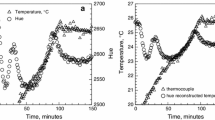Summary
An analysis is made of the transient temperature behavior of a transpiration-cooled porous matrix entering a planetary atmosphere with constant velocity and negative entry angle. The analysis is based on one dimensional heat conduction in a porous plate subjected to a time dependent heat flux at one side and cooled internally by mass injection from a constant temperature reservoir at the opposite side. An exact closed-form solution is obtained and temperature charts are presented for a wide range of Fourier number and coolant flow parameters.
Similar content being viewed by others
Abbreviations
- A :
-
surface area, ft2
- C :
-
constant, 17,600 Btu/ft3/2-sec
- C c :
-
constant pressure specific heat of coolant, Btu/lbm-°F
- g :
-
local gravitational acceleration, ft/sec2
- g c :
-
coolant flow parameter, defined by equation (15)
- h :
-
height of entry above planet surface, ft
- K 1 :
-
ratio of local heat flux to stagnation point heat flux
- K :
-
thermal conductivity of plate material, Btu/sec-ft-°F
- L :
-
plate thickness, ft
- m :
-
constant, 3.15
- m c :
-
coolant mass flow rate, lbm/sec
- M n :
-
roots of equation (33)
- n :
-
constant, 0.50
- N :
-
defined by equation (30)
- P :
-
porosity
- q :
-
surface heat flux, Btu/ft2-sec
- q 0 :
-
surface heat flux at t=0, Btu/ft2-sec, defined by (6)
- r :
-
distance from planet center, ft
- R :
-
radius of curvature at stagnation point, ft
- t :
-
time, sec
- T :
-
temperature, °F
- T c :
-
coolant supply temperature, °F
- V :
-
velocity, ft/sec
- x :
-
normal coordinate through plate, ft
- y :
-
altitude, ft
- α :
-
thermal diffusivity of plate, ft2/sec
- β :
-
atmospheric density decay parameter, 1/23500 ft−1
- γ :
-
flight path angle relative to local horizontal direction, positive for climbing and negative for descent, deg
- θ :
-
dimensionless temperature parameter, defined by (12)
- ξ :
-
dimensionless distance, defined by (13)
- ρ∞ :
-
free stream atmospheric density, slug/ft3
- ρ 0 :
-
atmospheric density at reference state, slug/ft3
- τ :
-
Fourier number, defined by (14)
- ω :
-
1/sec, defined by (7)
- ϖ :
-
flight entry parameter, defined by (16)
References
Wells, W. R. and C. H. McLellan, “One dimensional heat conduction through the skin of a vehicle upon entering a planetary atmosphere at constant velocity and entry angle”, NASA TN D-1476, October 1962.
Chapman, D. R., “An approximate analytical method for studying entry into planetary atmospheres”, NASA TR R-11, 1959. (Supersedes NACA TN 4276).
Manos, W. P. and D. E. Taylor, “Transient Heating at an axisymmetric stagnation point with mass addition”, International Development in Heat Transfer, 1961 International Heat Transfer Conference of ASME, AIChE, IME, ICE, Boulder, Colo. (American Society of Mechanical Engineers, New York, 1961) Part IV, pp. 731–736.
Mendelsohn, A. R., AIAA Journal 1, (1963) 1449–1450.
Detra, R. W., N. H. Kemp and F. R. Riddel, “Addendum to ‘Heat transfer to satellite vehicles re-entering the atmosphere’”. Jet Propulsion 27 (1957) 1256–1257.
Author information
Authors and Affiliations
Rights and permissions
About this article
Cite this article
Jiji, L.M. Transient temperature response of a porous matrix entering a planetary atmosphere. Appl. sci. Res. 15, 322–330 (1966). https://doi.org/10.1007/BF00411566
Received:
Issue Date:
DOI: https://doi.org/10.1007/BF00411566




